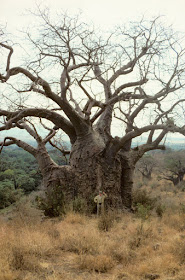The
Baobab Tree
“Tell
me about the Baobab Tree” I asked Ant.
“What
do you want to hear? Facts or Fables?
“Fables
are usually more interesting, so let's start with them”
I said.
I said.
“Well,
in the case of the Baobab, the facts are pretty interesting too.”
Ant,
John and I were sitting beneath such fabled tree, cool G&T swishing in plastic cups.
“I'll
give you the Fables first” Ant said. “As you may know, the
Natives call it the 'Upside
Down Tree', since its crown looks more like a ball of roots, and
this is how this happened: When the Good Lord created trees, the
Baobab stood beside a little pond and saw his reflection. Very
unhappy, he went back to the G.L. and told him that he was not happy
with his thin trunk. He would rather have a more powerful, manly
trunk. So the G.L. Let him have a big, thick trunk. The Baobab,
however, came back time and time again, complaining and asking for
changes in this and that.
Finally,
the G.L. got so angry with the Baobab, that he ripped it out of the
ground, turned it around and jammed it, crown first, back into the
earth. That's why the tree looks the way it does and why its called
the 'Upside Down Tree.'
An
other story, not confirmed, is that if you deliberately or
accidentally step on one of its blooms, a Lion will eat you before
the month is over.”
Is
this enough Fable?” Ant asked with a grin.
“More
than enough” I said. “Now gimme the fax, Man, nothin' but the
fax”
“Okay”,
Ant continued: “The Baobab is one of the oldest living things.
There is one in South Africa, estimated to be over six thousand years old. It has a circumference of 34 meters.
There is one in South Africa, estimated to be over six thousand years old. It has a circumference of 34 meters.
'Bains
Baobabs' in the Nxai Pan are estimated to be around three thousand
years old.
Baobabs
are the only tree which suck water throughout their entire structure,
right up to the highest twig. Other trees transport water only
between the stem and the bark.
So
if you strip a layer of bark around the tree, it dies.
Not so the Baobab.
This advantage has, however, its flip side. Elephants, seeking liquid throughout the dry Season, will dig into the tree in order to get to the moist wood.
Not so the Baobab.
This advantage has, however, its flip side. Elephants, seeking liquid throughout the dry Season, will dig into the tree in order to get to the moist wood.
It
is only when a Baobab is so severely damaged in this way, that it
will collapse due to its own weight.
By
the way, 'Creme of Tartar' is made from the innards of the fruit.
One
more thing” Ant added, “if you sit beneath a Baobab, and a fruit
falls and hits you on the head, it hurts like hell.
A Baobab showing hole at its base,
dug by Elephants in search of liquid.
The tree's crown, indeed, looks more like the ball of its roots.
Therefore the name: "Upside Down Tree."
above and below:
Baine's Baobab Trees, reflected in the Nxai Pan.
You want to know more of "Baine's Baobab?"
I'll tell you some other time.
One of the Big Ones, just at the border
between Kenya and Tanzania.
Zimbabwe's Premier Guide ( in my humble opinion)
Anthony Kaschula, seen here
in the cavity, dug by thirsty Elephants.
Ant organized the placement of sharply pointed rocks,
to prevent further damage to the tree by these thirsty Eles.
But, I ask, what happens to the thirsty Elephant when he/she is denied access to the moisture contained in the Baobab?
The perpetrator returns to the scene of his crime.
.
The ultimate result: Baobab so severely damaged by Eles,
that it collapsed of its own weight.
Caught! In flagranti








No comments:
Post a Comment